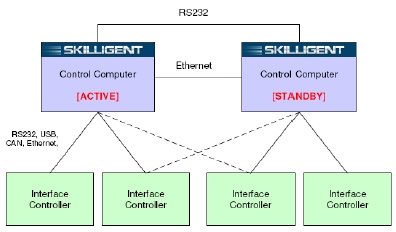When scientists at NASA send a command to a robot on Mars, it can take between 8 and 42 minutes before the operator knows that the command was performed successfully. Even here on earth, commands sent to local robots may still take up to a second to to be performed. It doesn’t sound like a lot but when you’re flying a plane using computers and software, latency may mean the difference between a graceful landing and crash.
It appears Skilligent has done much to solve this problem.
Last week, Skilligent and Siam UAV Industries announced the successful conclusion to an intensive program of flight testing to confirm the robustness, stability and high performance of a flight control system designed by Siam UAV Industries and based on Skilligent Fault-Tolerant Control Framework and Skilligent Operator Control Unit (OCU) software. The response times between the operator and the RPV (remotely piloted vehicle) were so good that “the combined latency at short ranges was approaching the latency of traditional RC hobby radios,” said Kollayuth Borpit, Siam UAV’s aeronautics engineer. “This made the Skilligent software a clear winner in our selection process.”
Here’s a video of the RPV being controlled by Skilligent’s OCU software, landing:
“Maturity, stability and reliability are mandatory requirements for avionics systems such as our RPV flight control product,” says Peter Srivaree-Ratana, President of Siam UAV Industries. “We are very pleased with performance of the Skilligent software which provides a reliable foundation for our products. Unlike other robotic software packages, the Skilligent software was designed from the ground up with the goal of achieving the shortest reaction time, lowest latency and maximum stability needed for demanding robotic control applications. In addition, Skilligent Fault-Tolerant Control Framework software provides us with a straightforward path to building a redundant autopilot system once we’ve tested our basic control technology in the currently non-redundant configuration. We chose the Skilligent products to shorten our time-to-market.”
What makes this performance especially impressive is the fact that safety and robustness was not compromised. Skilligent’s Fault-Tolerant Control Framework ensures that there is no single point of failure in the entire system.
The system provides many of the things you’d want from a fault-tolerant system in addition to redundant systems. It has automatic fault-detection and switch-over, support for multiple computers (up to 32), data replication, and great utilities such as remote control, statistics and logging. “Skilligent Fault-Tolerant Control Framework software comes with a real-time database optimized for online data recording. We use the database feature as a flight data recorder with 20 ms resolution. The database provides a simple way to upload the flight data into external programs such as Matlab or SimuLink. The collected data allow us to build precise models of aircraft response to commands given under various flight conditions. This feature
is important as we are designing innovative autopilot systems,” says Kollayuth Borpit.
It appears that Skilligent is slowly and quietly becoming a comprehensive provider of advanced robotics software. Their portfolio has expanded from autonomous robot-learning and computer vision systems to fault-tolerant and low-latency operator control systems. This combined with their support for many of the popular robotics development environments has made them a rocket on a launchpad waiting to take off.
Sources:



